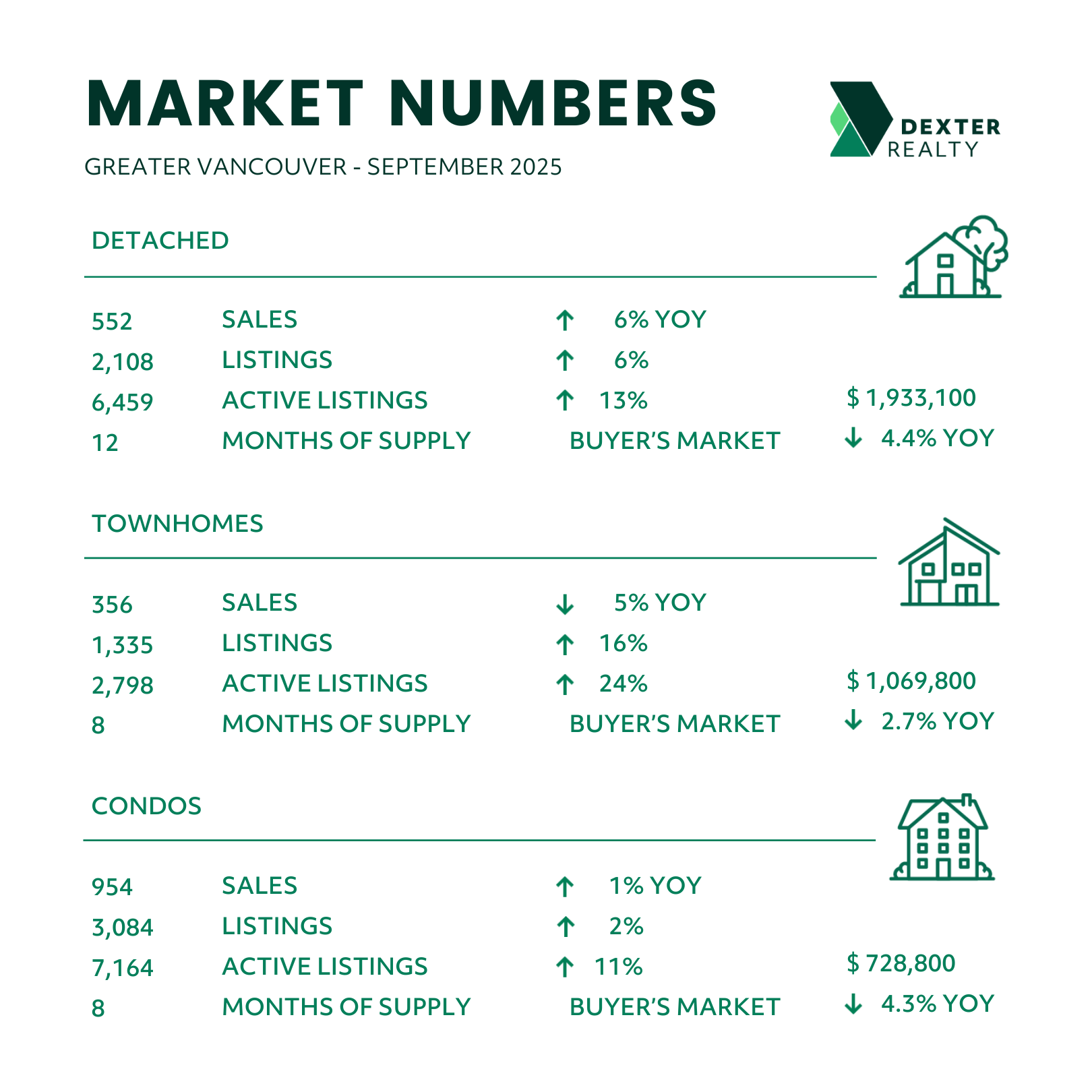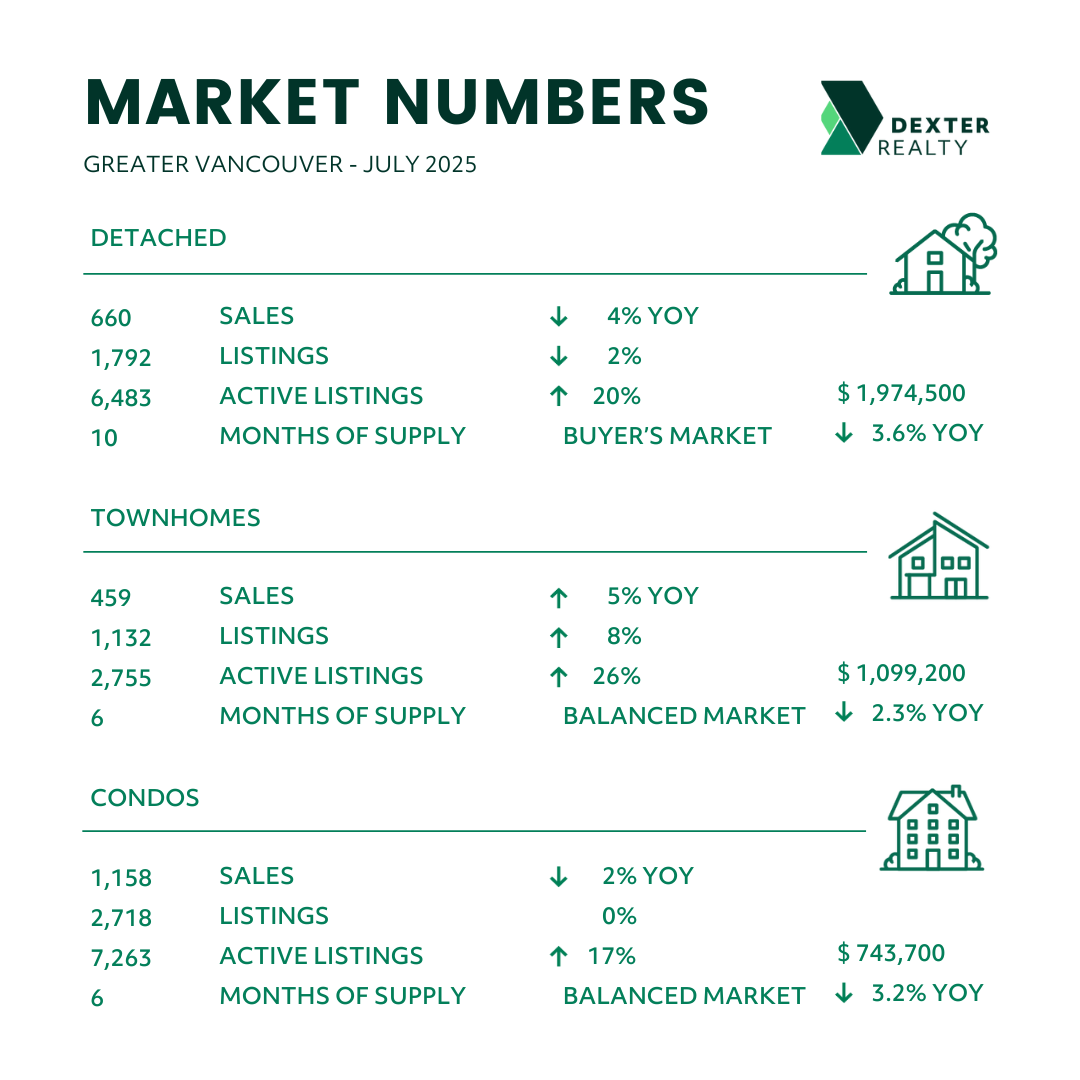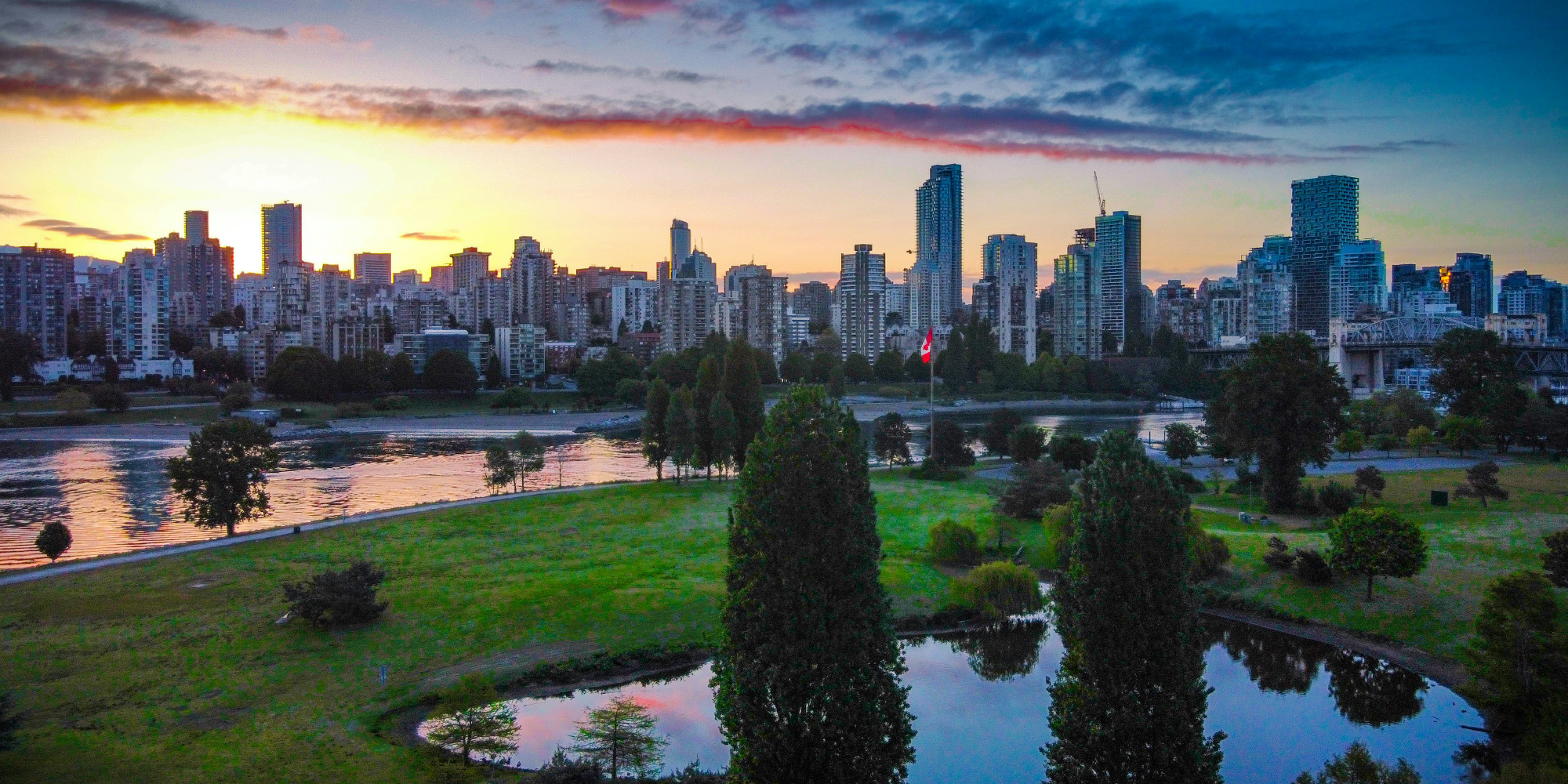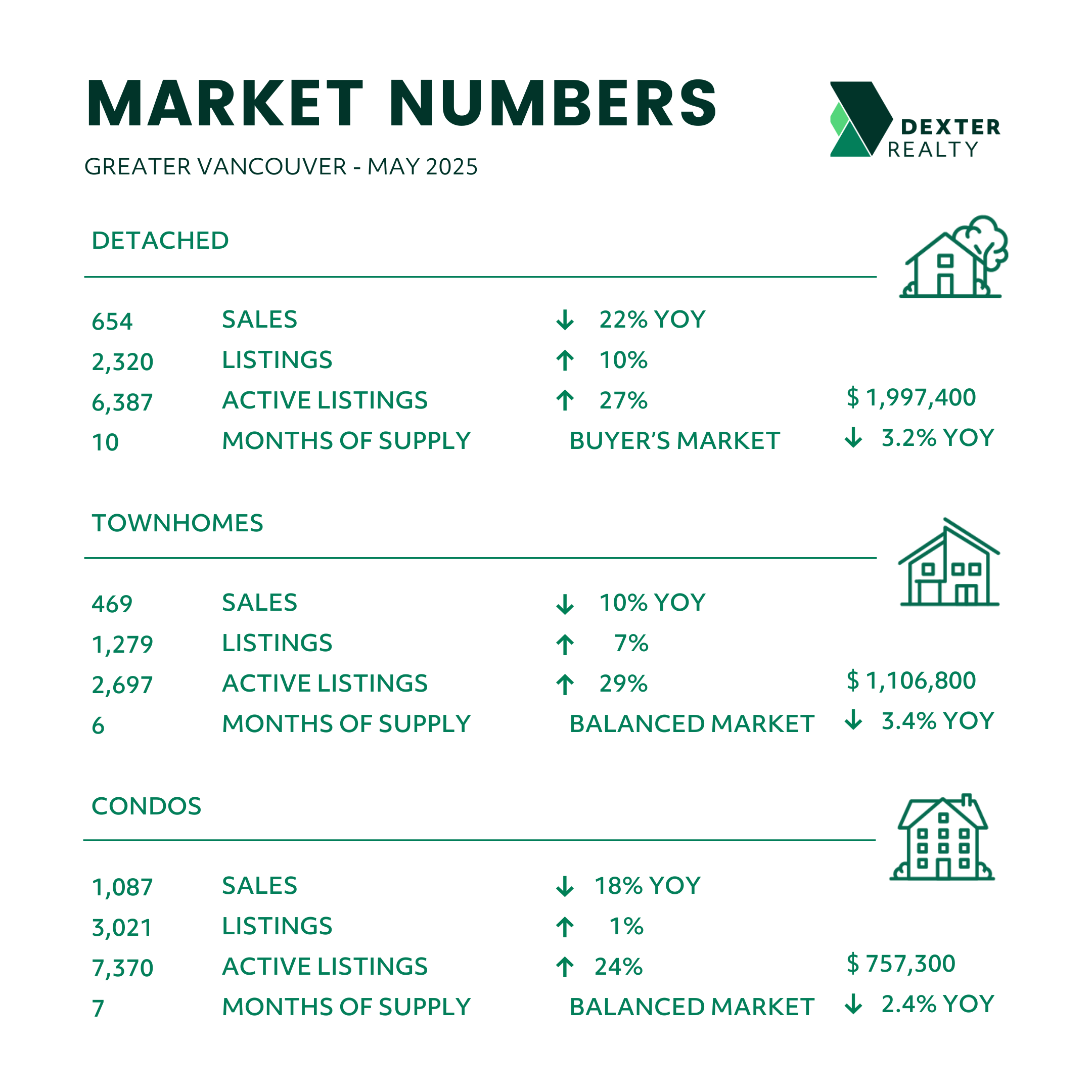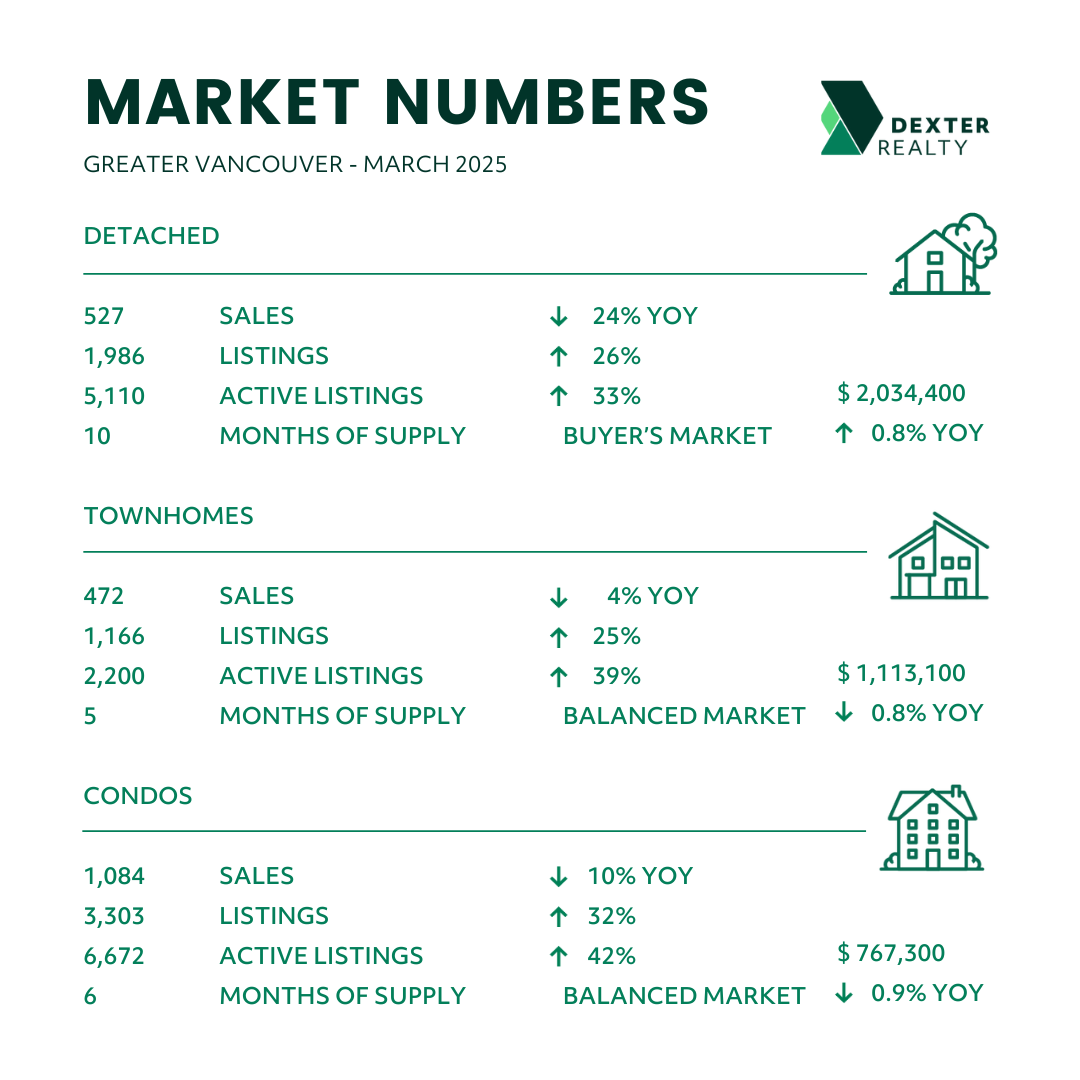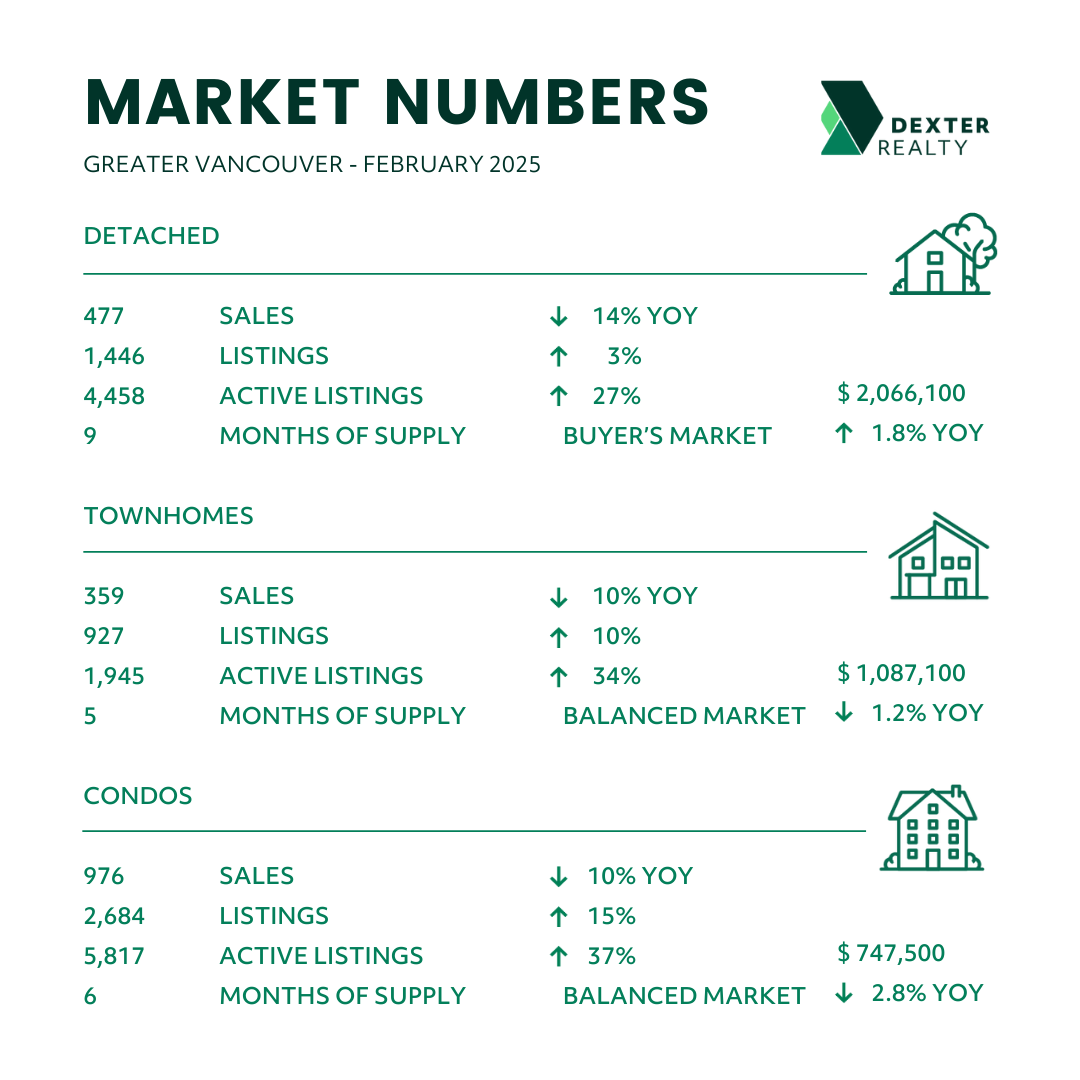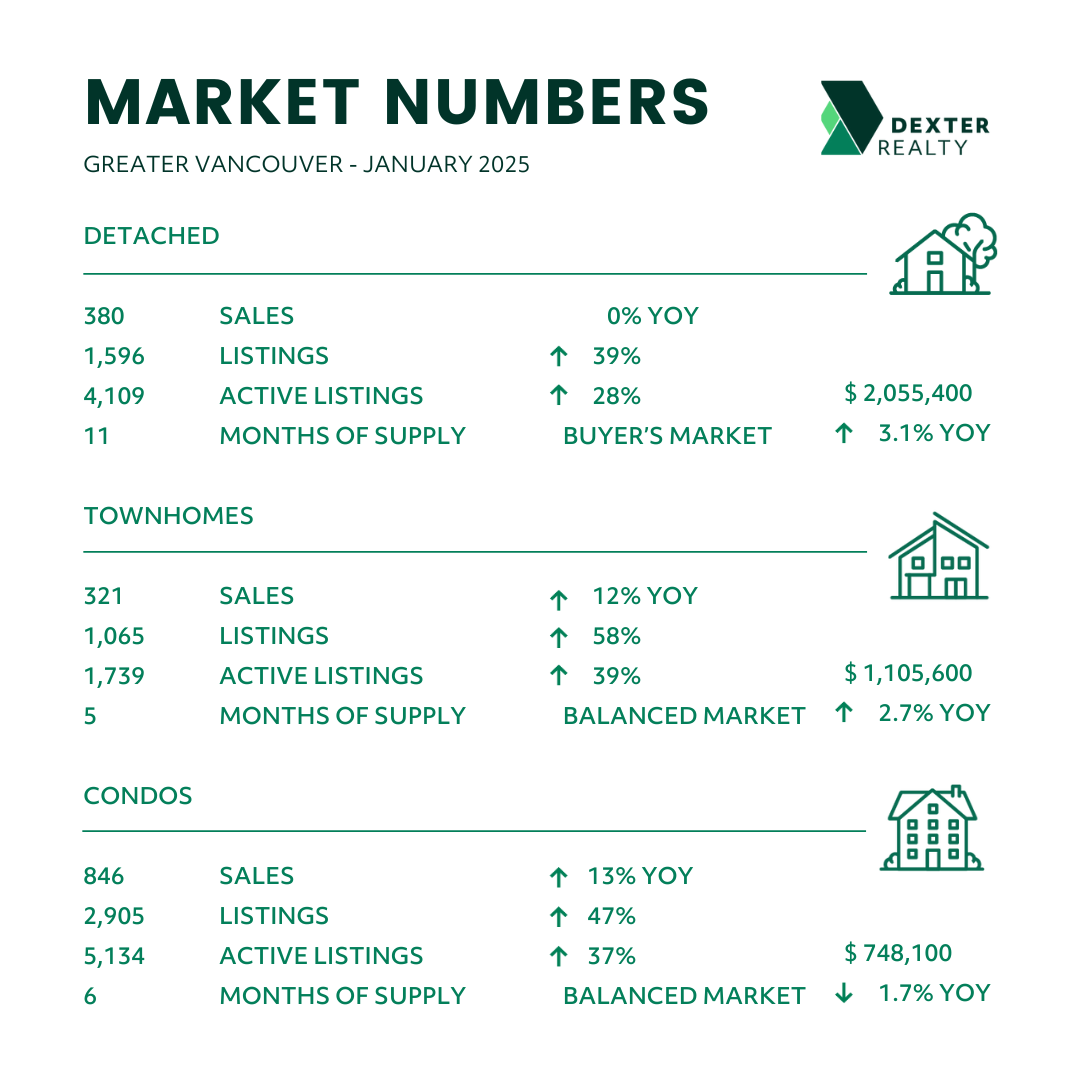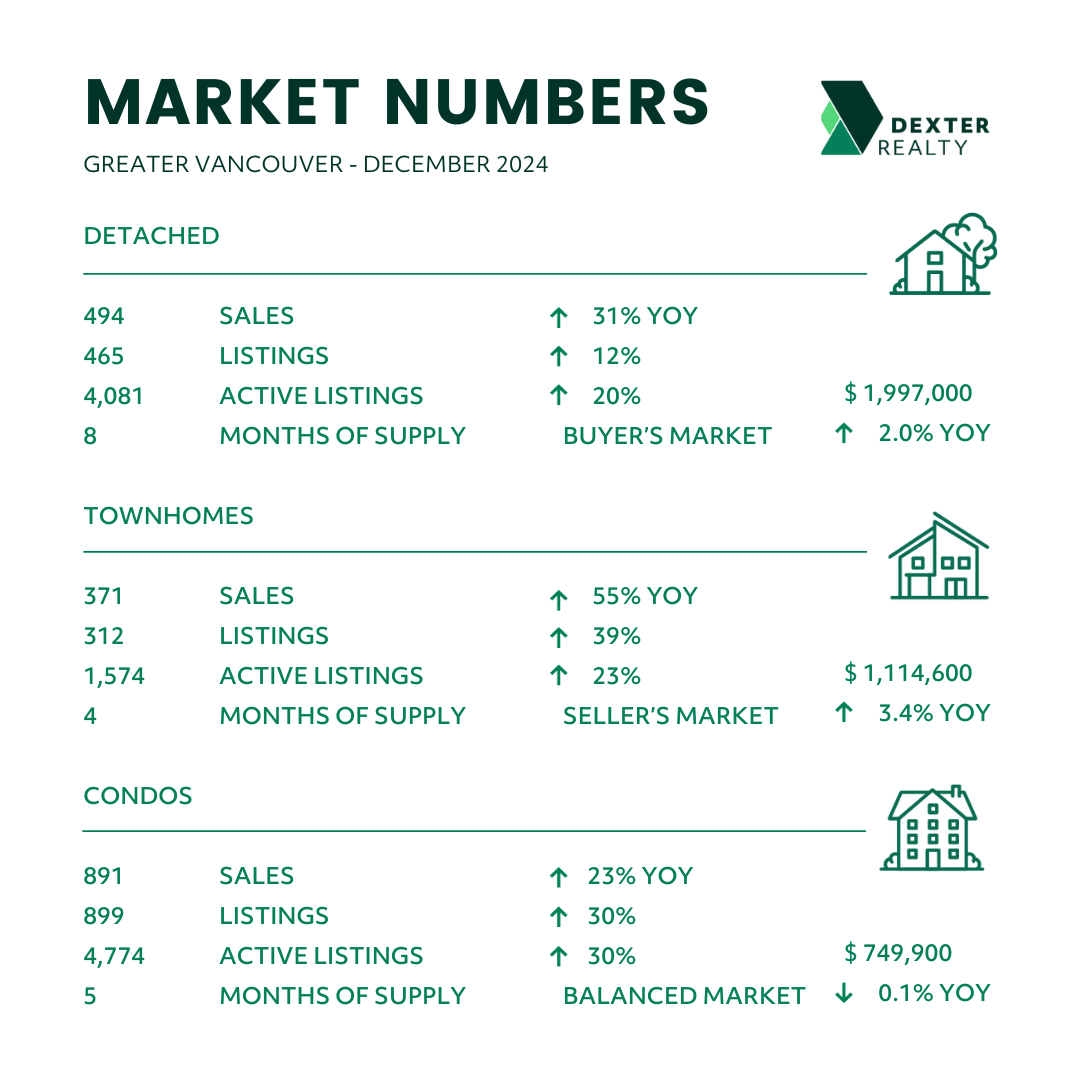Highlights of Dexter’s October 2025 report
Sales up 20% month-over-month across Greater Vancouver
Sales-to-listings ratio shoots up to 41%
Pent Up Demand at All Time Highs
Affordability got that much better with lower rates
Imagine if all those buyers and sellers decided that now was the time to act. Interest rates are no longer a brake on the market, but more so a motivation to buy with sub 4% mortgage rates now available. Variable rate mortgages haven’t looked this good in over 3 years! Markets move in unison. At some point, buyers and sellers will too, and with every month that demand builds, it comes closer to unleashing into the market. There are historical dips in the market such as the financial crisis of 2008 or the suite of government interventions after 2016 that lead to periods of optimal purchasing power. Those who purchased during those times didn’t regret it. It’s happened before and will happen again. Think about how many people in the last 3 years who have waited to buy their first home, move up, move down, part ways and sadly pass away. Movements happen in real estate out of necessity, that can only be held back so long. Life is too short to time the market perfectly, if you find the home you know you want – buy it!
Momentum Carries Metro Vancouver Market Into the Fall
October brought a much-needed lift to Metro Vancouver’s housing market after the seasonally quiet September. Across Greater Vancouver, sales rose sharply from September, new listings moderated, and inventory tightened, pushing the market back toward balanced conditions in some areas. Make no mistake, buyers have tremendous opportunity in this market still.
Stronger Sales, Tighter Supply in Greater Vancouver
Total residential sales in October across the region reached 2,255 units, up 20% from September and 15% higher than August. That’s a healthy improvement heading into the winter months and a clear sign of underlying market demand. Year-over-year, sales were down 15% from October 2024 but they were only down 1% from July, which was the monthly high for 2025. Many buyers are taking advantage of recent interest rate drops and continued elevated listing inventory. In comparison to October 2023, sales are up a solid 17%, reinforcing that demand is there, with plenty of it still waiting in the wings.
Active listings ended the month at 16,393, down 4% from August and 13% higher than last year, marking the first time in several months that inventory began to contract meaningfully. With fewer new listings entering the system, 5,518 in October, down 17% from September, buyers are now seeing less new competition for desirable homes.
The sales-to-listings ratio climbed to 41%, up from 28% in September. That’s pushing some markets to balanced territory, and a clear shift from the slower late-summer pace. Months of inventory fell to 7 months, down from 9, suggesting a tightening dynamic where well-priced listings are attracting offers faster.
Greater Vancouver sales in October were 15% below the 10-year average, better than the previous months where September was 20% below the 10-year average, August was 19% below the 10-year average, but like July at 14% below the 10-year average. The market is showing signs of buyers making moves, and with this latest interest rate drop by the Bank of Canada, there is more motivation to get out and buy.
Greater Vancouver townhome sales in October were down 4% year-over-year after being down 5% compared to September last year, while condos sales dropped to 23% down year-over-year after being up 1% last month. With the stock of condos piling up, literally, buyers have the best opportunity in decades to purchase new product at prices below what it cost to build them. Expect condo sales to propel in the coming months as this supply is consumed. A great opportunity for first time buyers that can take advantage of GST rebates for new properties up to $1.5M. Detached sales dropped in October to 4% below October last year after being up 6% year-over-year in September. Townhome inventory shrunk in October with many areas shifting back to seller market conditions, showing just how much is missing in the “missing middle” segment of the market. This is a continued ask of the government to look at addressing this supply constrained type of home which prevents many buyers from moving up or moving down in the market.
Active Listings Shrink in October
Inventory dropped down as is seasonally typical for October. Active listings finished October at 16,393, up 13% from last year’s 14,477, and a drop of 4% from September’s 17,079. This was a more significant drop from September compared to last year when there was a smaller decline in active listings between September and October, and it was much different than 2023 when the number of active listings increased between September and October. The window of choice and opportunity for buyers shifted in October, and this could be a signal for buyers not to continue the waiting game. With the choice of listings, and good listings at that, declining, as buyers come forward more competition can become present in the market.
The region shifted out of a buyer’s market to a balanced market, technically, in October. The months of supply dropped down to 7 from 9 in September which is the lowest it has been since April of this year.
The number of new listings in October were 16% above the 10-year average, after September was 20% above the 10-year average. With the decline in new listings, sellers may be starting to resist in the market and shifting towards the wait and see game as well. Buyers should be careful that waiting could lead to less available properties, especially those properties with willing sellers.
Vancouver: Buyers Step Back In, But a Tale of Two Markets
Vancouver Westside did well in detached and townhome segments while the condo market struggled to keep up. The one saving grace for condos was a significant drop in new listings. Detached and townhouse segments are drawing renewed attention, with sellers pricing or negotiating in line with buyer expectations. The sales-to-listings ratio rose to 38% overall from 24%, edging closer balanced range, while inventory dropped to 3,100 listings.
Vancouver Eastside was reliable and active as it continued its path of showing strength, with 269 sales, up 29% from September and 16% above last year while achieving the highest number by month this year. Active listings eased to 1,654, and the sales-to-listings ratio jumped to 45%, signaling a potential trend to confident, balanced demand.
The Suburb Story
Areas east of Vancouver showed less growth in sales in October compared to Vancouver, perhaps a sign of a market shifting outwards as a lagging trend. September saw the opposite effect, but sales corrections typically start from Vancouver so this could be a sign of what’s to come in the suburbs. Port Moody was one of the better performing markets in the suburbs in October, which is surprising given the price points are typically on the higher side. Pitt Meadows saw double the total sales in October compared to the previous month and achieved one of the better months this year for that municipality.
Ladner & Tsawwassen: South Delta had some strong numbers in October. Ladner with 30 sales, a balanced 50% ratio, and consistent demand through the fall. Tsawwassen had 51 sales, up 34% from September and 42% above last year, with a 55% ratio, signaling one of the most active sales to listing ratios in the Lower Mainland. Buyers continue to chase lifestyle-driven value, and South Delta is delivering it.
Fraser Valley
The Fraser Valley kept the positive trend rolling, posting 1,123 sales, up 17% from September. Active listings fell 4% to 10,121, while new listings dropped 14% month-over-month, tightening conditions.
Average prices climbed 0.1% month-over-month remaining under $1 million, while months of inventory dropped to 9 from 11, showing meaningful progress toward balanced conditions but still technically a buyer’s market.
Detached homes in North Delta and Langley saw the most activity, with townhouse demand following closely behind. After months of hesitation, confidence is quietly returning across the Valley.
Looking Ahead
October showed what a healthy market could look like with stronger sales, and a balancing of conditions with inventory declining while demand picks up. The excess quality listings from earlier in the year are being absorbed, and both buyers and sellers are adjusting to the new rate and home price landscape.
While we’re unlikely to see fireworks through the winter, the fundamentals are encouraging with fewer new listings, steady demand, and pricing that will try to hold its ground with quality listings. As 2025 winds down, confidence is quietly creeping back with demand ready to enter the market after playing the waiting game for the past 3 years and beyond save for the Covid years. So if you are a buyer, why wait?
Here’s a summary of the numbers:
Greater Vancouver: Total Units Sold in October were 2,255 up from 1,875 (20%) in September, up from 1,959 (15%) in August, down from 2,286 (1%) in July, down from 2,632 (14%) in October 2024, and up from 1,926 (17%) in October 2023; Active Listings were at 16,393 at month end compared to 14,477 at that time last year (up 13%) and 17,079 at the end of August (down 4%); the 5,518 New Listings in October were down 17% compared to September, up 28% compared to August, down 4% compared to July, down 1% compared to October 2024, and up 16% compared to October 2023. Month’s supply of total residential listings is down to 7 month’s supply from 9 (balanced market conditions) and sales to listings ratio of 41% compared to 28% in September, 47% in October 2024, and 42% in October 2023.
Month-over-month, the house price index is down 0.8% and in the last 12 months down 3.4%.
Vancouver Westside: Total Units Sold in October were 403 up from 316 (28%) in September, up from 381 (6%) in August, up from 396 (2%) in July, down from 472 (15%) in October 2024, and up from 352 (14%) in October 2023; Active Listings were at 3,104 at month end compared to 3,106 at that time last year (own 0.1%) and 3,188 at the end of August (down 1%); the 1,056 New Listings in October were down 18% compared to September, up 38% compared to August, up 3% compared to July, down 7% compared to October 2024, and up 6% compared to October 2023. Month’s supply of total residential listings is down to 8 month’s supply from 10 (balanced market conditions) and sales to listings ratio of 38% compared to 24% in September, 41% in October 2024, and 35% in October 2023.
Month-over-month, the house price index is down 1.1% and in the last 12 months down 2.5%.
Vancouver East Side: Total Units Sold in October were 269 up from 208 (29%) in September, up from 219 (23%) in August, up from 242 (11%) in July, down from 282 (5%) in October 2024, and up from 231 (16%) in October 2023; Active Listings were at 1,654 at month end compared to 1,512 at that time last year (up 9%) and 1,740 at the end of August (down 5%); the 603 New Listings in October were down 25% compared to September, up 31% compared to August, down 0.5% compared to July, down 2% compared to October 2024, and up 6% compared to October 2023. Month’s supply of total residential listings is down to 6 month’s supply from 8 (balanced market conditions) and sales to listings ratio of 45% compared to 26% in September, 46% in October 2024, and 41% in October 2023.
Month-over-month, the house price index is down 0.7% and in the last 12 months down 4.0%.
North Vancouver: Total Units Sold in October were 188 up from 159 (18%) in September, up from 139 (35%) in August, down from 190 (1%) in July, down from 224 (16%) in October 2024, and down from 194 (3%) in October 2023; Active Listings were at 1,000 at month end compared to 848 at that time last year (up 18%) and 1,072 at the end of August (down 7%); the 426 New Listings in October were down 30% compared to September, up 40% compared to August, down 8% compared to July, down 13% compared to October 2024, and up 14% compared to October 2023. Month’s supply of total residential listings is down to 5 month’s supply from 7 (balanced market conditions) and sales to listings ratio of 44% compared to 26% in September, 46% in October 2024, and 52% in October 2023.
Month-over-month, the house price index is down 0.8% and in the last 12 months up 0.8%.
West Vancouver: Total Units Sold in October were 58 up from 52 (12%) in September, up from 43 (35%) in August, down from 62 (6%) in July, down from 59 (2%) in October 2024, and up from 53 (9%) in October 2023; Active Listings were at 761 at month end compared to 707 at that time last year (up 8%) and 781 at the end of August (down 3%); the 222 New Listings in October were down 20% compared to September, up 59% compared to August, up 6% compared to July, up 4% compared to October 2024, and up 32% compared to October 2023. Month’s supply of total residential listings is down to 13 month’s supply from 15 (buyer’s market conditions) and sales to listings ratio of 26% compared to 19% in September, 28% in October 2024, and 32% in October 2023.
Month-over-month, the house price index is down 0.3% but in the last 12 months down 5.6%.
Richmond: Total Units Sold in October were 236 up from 191 (24%) in September, up from 223 (6%) in August, down from 241 (2%) in July, down from 290 (19%) in October 2024, and up from 217 (9%) in October 2023; Active Listings were at 2,137 at month end compared to 1,657 at that time last year (up 29%) and 2,210 at the end of August (down 3%); the 606 New Listings in October were down 15% compared to September, up 9% compared to August, down 5% compared to July, up 3% compared to October 2024, and up 26% compared to October 2023. Month’s supply of total residential listings is down to 9 month’s supply from 12 (buyer’s market conditions) and sales to listings ratio of 39% compared to 27% in September, 49% in October 2024, and 45% in October 2023.
Month-over-month, the house price index is down 0.6% and in the last 12 months down 4.9%.
Burnaby East: Total Units Sold in October were 32 down from 34 (6%) in September, up from 21 (52%) in August, up from 30 (7%) in July, up from 25 (28%) in October 2024, and up from 21 (52%) in October 2023; Active Listings were at 212 at month end compared to 158 at that time last year (up 34%) and 219 at the end of August (down 3%); the 76 New Listings in October were down 21% compared to September, up 19% compared to August, down 8% compared to July, up 10% compared to October 2024, and up 58% compared to October 2023. Month’s supply of total residential listings is up to 7 month’s supply from 6 (balanced market conditions) and sales to listings ratio of 42% compared to 35% in September, 36% in October 2024, and 44% in October 2023.
Month-over-month, the house price index is down 2.5% and in the last 12 months down 8.9%.
Burnaby North: Total Units Sold in October were 147 up from 137 (7%) in September, up from 115 (28%) in August, down from 164 (10%) in July, down from 168 (12%) in October 2024, and up from 137 (7%) in October 2023; Active Listings were at 880 at month end compared to 791 at that time last year (up 11%) and 908 at the end of August (down 3%); the 333 New Listings in October were down 12% compared to September, up 30% compared to August, down 10% compared to July, down 13% compared to October 2024, and up 14% compared to October 2023. Month’s supply of total residential listings is down to 6 month’s supply from 7 (balanced market conditions) and sales to listings ratio of 44% compared to 36% in September, 57% in October 2024, and 47% in October 2023.
Month-over-month, the house price index is down 1.5% and in the last 12 months down 5.3%.
Burnaby South: Total Units Sold in October were 104 up from 96 (8%) in September, up from 103 (1%) in August, down from 142 (27%) in July, down from 166 (37%) in October 2024, and down from 120 (13%) in October 2023; Active Listings were at 814 at month end compared to 675 at that time last year (up 21%) and 841 at the end of August (down 3%); the 281 New Listings in October were down 8% compared to September, up 36% compared to August, down 5% compared to July, down 1% compared to October 2024, and up 24% compared to October 2023. Month’s supply of total residential listings is down to 8 month’s supply from 9 (buyer’s market conditions) and sales to listings ratio of 37% compared to 32% in September, 58% in October 2024, and 53% in October 2023.
Month-over-month, the house price index is down 0.8% and in the last 12 months down 4.0%.
New Westminster: Total Units Sold in October were 98 up from 84 (17%) in September, up from 73 (34%) in August, down from 99 (1%) in July, down from 120 (18%) in October 2024, and up from 81 (21%) in October 2023; Active Listings were at 596 at month end compared to 480 at that time last year (up 24%) and 626 at the end of August (down 5%); the 245 New Listings in October were down 8% compared to September, up 30% compared to August, up 4% compared to July, down 4% compared to October 2024, and up 60% compared to October 2023. Month’s supply of total residential listings is down to 6 month’s supply from 7 (balanced market conditions) and sales to listings ratio of 40% compared to 31% in September, 47% in October 2024, and 53% in October 2023.
Month-over-month, the house price index is down 1.0% and in the last 12 months down 4.7%.
Coquitlam: Total Units Sold in October were 185 up from 167 (11%) in September, up from 164 (13%) in August, down from 205 (10%) in July, down from 246 (25%) in October 2024, and up from 167 (11%) in October 2023; Active Listings were at 1,341 at month end compared to 1,102 at that time last year (up 22%) and 1,322 at the end of August (up 1%); the 528 New Listings in October were down 7% compared to September, up 25% compared to August, up 5% compared to July, up 13% compared to October 2024, and up 30% compared to October 2023. Month’s supply of total residential listings is down to 7 month’s supply from 8 (balanced market conditions) and sales to listings ratio of 35% compared to 29% in September, 53% in October 2024, and 41% in October 2023.
Month-over-month, the house price index is down 0.5% and in the last 12 months down 4.0%.
Port Moody: Total Units Sold in October were 65 up from 46 (41%) in September, up from 46 (41%) in August, down from 66 (2%) in July, down from 66 (2%) in October 2024, and up from 51 (27%) in October 2023; Active Listings were at 386 at month end compared to 253 at that time last year (up 53%) and 390 at the end of August (down 1%); the 182 New Listings in October were down 5% compared to September, up 114% compared to August, up 14% compared to July, up 25% compared to October 2024, and up 114% compared to October 2023. Month’s supply of total residential listings is down to 6 month’s supply from 8 (balanced market conditions) and sales to listings ratio of 36% compared to 24% in September, 45% in October 2024, and 60% in October 2023.
Month-over-month, the house price index is up 0.6% and in the last 12 months down 2.3%.
Port Coquitlam: Total Units Sold in October were 69 up from 45 (53%) in September, up from 46 (50%) in August, down from 85 (19%) in July, down from 77 (10%) in October 2024, and up from 54 (28%) in October 2023; Active Listings were at 374 at month end compared to 328 at that time last year (up 14%) and 394 at the end of August (down 5%); the 150 New Listings in October were down 18% compared to September, up 24% compared to August, up 1% compared to July, up 1% compared to October 2024, and up 32% compared to October 2023. Month’s supply of total residential listings is down to 5 month’s supply from 9 (balanced market conditions) and sales to listings ratio of 46% compared to 25% in September, 52% in October 2024, and 47% in October 2023.
Month-over-month, the house price index is down 0.1% and in the last 12 months down 3.7%.
Pitt Meadows: Total Units Sold in October were 29 up from 15 (93%) in September, up from 19 (53%) in August, up from 25 (16%) in July, down from 32 (9%) in October 2024, and up from 21 (38%) in October 2023; Active Listings were at 129 at month end compared to 121 at that time last year (up 6%) and 151 at the end of August (down 15%); the 47 New Listings in October were down 10% compared to September, up 4% compared to August, down 24% compared to July, down 17% compared to October 2024, and the same compared to October 2023. Month’s supply of total residential listings is down to 4 month’s supply from 10 (seller’s market conditions) and sales to listings ratio of 61% compared to 28% in September, 56% in October 2024, and 44% in October 2023.
Month-over-month, the house price index is down 3.7% and in the last 12 months down 9.3%.
Maple Ridge: Total Units Sold in October were 110 up from 97 (13%) in September, down from 128 (14%) in August, down from 122 (10%) in July, down from 143 (23%) in October 2024, and the same as October 2023; Active Listings were at 951 at month end compared to 848 at that time last year (up 12%) and 985 at the end of August (down 3%); the 293 New Listings in October were down 11% compared to September, up 22% compared to August, down 17% compared to July, down 23% compared to October 2024, and down 11% compared to October 2023. Month’s supply of total residential listings is down to 9 month’s supply from 10 (buyer’s market conditions) and sales to listings ratio of 37% compared to 29% in September, 45% in October 2024, and 33% in October 2023.
Month-over-month, the house price index is down 1.2% and in the last 12 months down 4.5%.
Ladner: Total Units Sold in October were 30 down from 34 (18%) in September, up from 26 (15%) in August, down from 36 (17%) in July, down from 31 (3%) in October 2024, and up from 24 (25%) in October 2023; Active Listings were at 156 at month end compared to 142 at that time last year (up 10%) and 168 at the end of August (down 7%); the 60 New Listings in October were down 17% compared to September, up 18% compared to August, down 17% compared to July, the same compared to October 2024, and up 36% compared to October 2023. Month’s supply of total residential listings is the same at 5 month’s supply (balanced market conditions) and sales to listings ratio of 50% compared to 47% in September, 51% in October 2024, and 55% in October 2023.
Month-over-month, the house price index is down 2.3% and in the last 12 months down 5.6%.
Tsawwassen: Total Units Sold in October were 51 up from 38 (34%) in September, up from 39 (31%) in August, up from 30 (70%) in July, up from 36 (42%) in October 2024, and up from 27 (89%) in October 2023; Active Listings were at 314 at month end compared to 223 at that time last year (up 41%) and 329 at the end of August (down 5%); the 92 New Listings in October were down 10% compared to September, up 14% compared to August, down 19% compared to July, up 15% compared to October 2024, and up 23% compared to October 2023. Month’s supply of total residential listings is down to 6 month’s supply from 9 (balanced market conditions) and sales to listings ratio of 55% compared to 37% in September, 45% in October 2024, and 36% in October 2023.
Month-over-month, the house price index is down 2.5% and in the last 12 months down 4.5%.
Fraser Valley: Sales in October were up 17% at 1,123 compared to September at 962 and were down 16% from October 2024 at 1,330. New listings were down 14% at 2,967 from September at 3,447 and down 7% from October 2024 at 3,194. The average price of $987,199 was up 0.1% month-over-month and was down 3% year-over-year. Active listings were down 4% to 10,121 compared to last month at 10,583 and up 15% from October 2024 at 8,799. Month’s supply of total residential listings is down to 9 months supply from 11 months (buyer’s market conditions).
Month-over-month, the house price index is down 0.7% and in the last 12 months down 5.3%.



